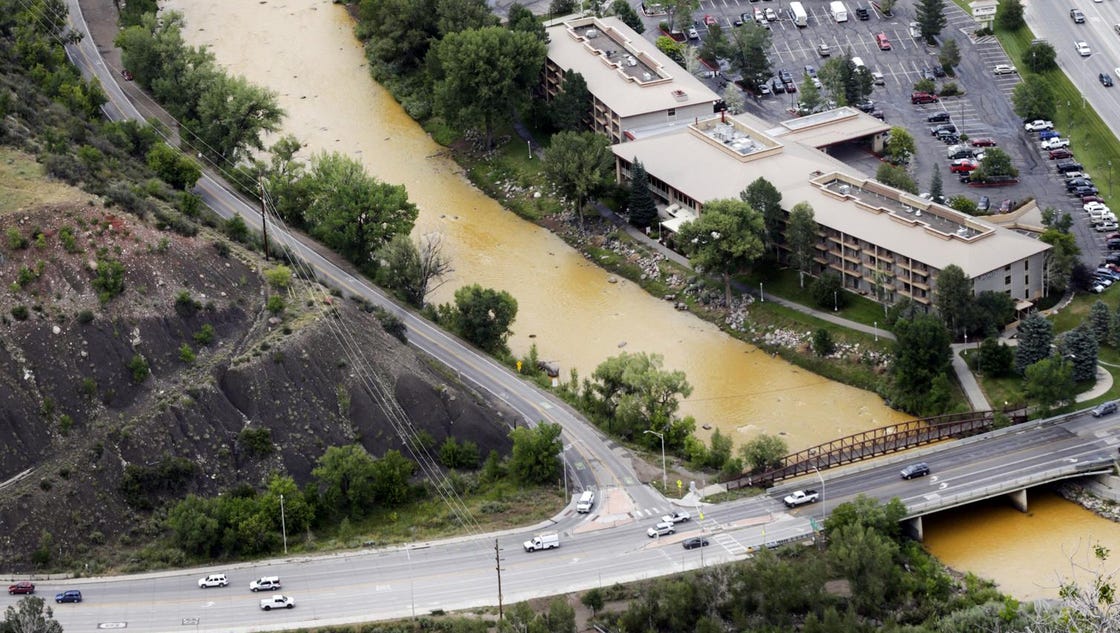Contamination And Reclamation: Addressing The Legacy Of Abandoned Gold Mines

Table of Contents
Types of Contamination from Abandoned Gold Mines
Abandoned gold mines leave behind a complex cocktail of pollutants. Understanding the nature of this contamination is the first step toward effective remediation. The primary forms of contamination include heavy metal pollution, acid mine drainage (AMD), and sediment and erosion.
Heavy Metal Contamination
The extraction of gold often involves the use of chemicals like mercury, leading to significant heavy metal contamination. Other heavy metals, such as arsenic, lead, and cadmium, are also commonly found in and around abandoned gold mines. These toxins accumulate in the soil and water, posing severe risks to human health and the environment.
- Specific examples: The mercury contamination of rivers near abandoned gold mines in the Amazon rainforest, the lead poisoning incidents associated with abandoned mines in various parts of Africa.
- Health impacts: Heavy metal exposure can cause neurological damage, developmental problems in children, kidney disease, cancer, and reproductive issues.
Acid Mine Drainage (AMD)
Acid mine drainage is a particularly pervasive problem. It occurs when pyrite (iron sulfide), a mineral commonly found in gold-bearing rocks, is exposed to air and water. This triggers a chemical reaction that produces sulfuric acid, which then leaches heavy metals from the surrounding rocks and soil.
- Pyrite oxidation: The chemical reaction of pyrite with oxygen and water generates sulfuric acid (H2SO4) and dissolved iron.
- Environmental damage: AMD severely degrades water quality, making it unsuitable for drinking or supporting aquatic life. It acidifies soil, impacting plant growth and potentially mobilizing other contaminants.
Sediment and Erosion
Abandoned mine sites often lack proper stabilization, leading to increased erosion and sediment runoff. This sediment pollutes waterways, impacting aquatic ecosystems and water quality.
- Impact on downstream ecosystems: Increased turbidity reduces sunlight penetration, harming aquatic plants and disrupting the food web. Sediment can also smother benthic organisms.
- Methods for mitigating sediment pollution: Implementing erosion control measures such as revegetation, terracing, and the construction of sediment basins.
Challenges in Reclamation of Abandoned Gold Mines
Reclaiming abandoned gold mines is a complex and costly undertaking. Numerous obstacles hinder effective remediation efforts.
- Identifying and assessing contamination: Determining the extent and nature of contamination can be challenging, requiring extensive sampling and analysis.
- Financial constraints: The cost of remediation can be prohibitive, particularly for sites with widespread and severe contamination. Funding often falls short of what is needed.
- Lack of regulatory frameworks: In many regions, inadequate regulations and enforcement mechanisms hamper remediation efforts. Clear liability and responsibility are often unclear.
- Complexities of remediation technologies: There is no one-size-fits-all solution. The choice of remediation technology depends on the specific contaminants present, site conditions, and budget constraints.
- Land ownership and liability: Determining ownership and establishing responsibility for remediation can be a lengthy and complex legal process.
Technological Limitations
Current remediation technologies, while effective in some cases, have limitations.
- Examples of existing remediation techniques: Bioremediation, phytoremediation, chemical treatment, capping, and water treatment plants.
- Challenges associated with each technique: Bioremediation can be slow; phytoremediation is limited by the suitability of plant species and climate; chemical treatments can be expensive and may generate hazardous waste; capping may require long-term maintenance.
Effective Reclamation Strategies for Abandoned Gold Mines
Successful reclamation requires a multifaceted approach that incorporates various remediation techniques and considers long-term sustainability.
Bioremediation
Bioremediation uses microorganisms to break down or transform pollutants into less harmful substances.
- Examples of successful bioremediation projects: Several successful projects have utilized bacteria and fungi to degrade heavy metals and other pollutants in mine tailings.
- Advantages and disadvantages: Bioremediation is a cost-effective and environmentally friendly option, but it can be slow and its effectiveness depends on environmental conditions.
Phytoremediation
Phytoremediation involves using plants to extract, immobilize, or degrade contaminants from the soil or water.
- Examples of suitable plant species: Certain plants are known for their ability to accumulate heavy metals from the soil, such as sunflowers and certain willow species.
- Limitations of phytoremediation: The effectiveness depends on plant species, climate, and the types of contaminants.
Engineering Solutions
Engineering solutions, such as capping, sealing, and water treatment plants, can be crucial in controlling the spread of contamination.
- Cost-effectiveness and long-term maintenance considerations: While effective, these methods often require significant upfront investment and ongoing maintenance.
- Examples of successful engineering solutions: The implementation of engineered barriers to prevent the further spread of contaminated water.
Conclusion: Securing a Sustainable Future: Reclamation of Abandoned Gold Mines
The contamination stemming from abandoned gold mines presents a significant environmental and public health challenge. The diversity of contaminants, coupled with the financial and logistical hurdles involved in remediation, necessitates a comprehensive and collaborative approach. Effective reclamation strategies must integrate multiple techniques, taking into account site-specific factors and long-term sustainability. Governments, mining companies, and environmental organizations must work together to develop and implement effective policies and technologies for abandoned mine reclamation, gold mine remediation, and abandoned gold mine cleanup. Learn more about the organizations working on this critical issue, and advocate for stronger regulations to prevent future contamination and ensure the responsible management of mining sites. Let's work together to heal the scars of the past and secure a sustainable future.

Featured Posts
-
 Smokey Robinson Comments On Diana Ross Affair Song Speculation
May 06, 2025
Smokey Robinson Comments On Diana Ross Affair Song Speculation
May 06, 2025 -
 Bradley Cooper And Gigi Hadid A Birthday Reveal On Instagram
May 06, 2025
Bradley Cooper And Gigi Hadid A Birthday Reveal On Instagram
May 06, 2025 -
 Stephen A Smith Pays Tribute To Gregg Popovich Analysis And Reaction
May 06, 2025
Stephen A Smith Pays Tribute To Gregg Popovich Analysis And Reaction
May 06, 2025 -
 Rumer Williss Cryptic Remark On Ashton Kutcher Backfires
May 06, 2025
Rumer Williss Cryptic Remark On Ashton Kutcher Backfires
May 06, 2025 -
 Tracking Global Commodity Markets 5 Key Charts To Monitor This Week
May 06, 2025
Tracking Global Commodity Markets 5 Key Charts To Monitor This Week
May 06, 2025
